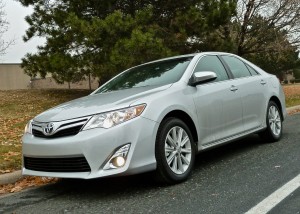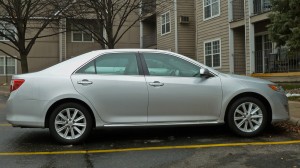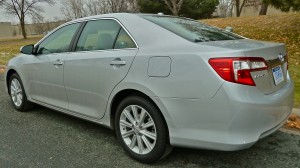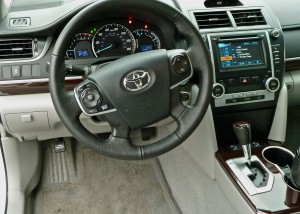New-generation Camry adds sporty side
By John Gilbert
It’s not often anyone mentions “Camry” and “sporty” in the same story, let alone the same sentence, but here goes: The newest revision of Toyota’s iconic sedan comes close to offering all things to all buyers — including a major advancement in real-world sportiness.
The 2012 Toyota Camry, in middle-model trim, offers a 2.5-liter 4-cylinder with its 6-speed automatic transmission augmented by fingertip paddles on the steering wheel to facilitate manually overriding the automatic. The Honda Accord, forever Camry’s biggest competitor, and universally considered sportier and peppier, doesn’t offer either a 6-speed automatic and much less paddles.
Such devices aren’t necessarily earth-shaking these days, with other sporty sedans making them readily available, and Toyota’s 6-speed automatic is not new, but the paddles allow Toyota to emerge onto that plateau of useful sportiness without fanfare. Which might be too bad, because a lot of buyers who have grown used to criticism of the Camry might add it to their list of considerations if they knew of such a bold upgrade.
Success in the automobile world often leads to criticism, and the Camry has undergone its share of both. Since the Camry took over as the No. 1 selling car in the U.S., critics have sniped at it for being as boring as a kitchen appliance, devoid of character, sportiness, or even style. Much of the criticism had a foundation, because Toyota grew more conservative with the Camry as its popularity grew. Toyota was so intent on building a car for the masses, for those who aren’t interested in spirited driving, and maybe even for those who find driving a drudgery and just want a trouble-free conveyance from Point A to Point B, that it seemed to round off the Camry’s edges in more ways than just styling. If you have enough support to sell more Camrys than anybody else sells any competitor, then why worry about the fringe hot-rodders? On the other hand, why not capture them, too?
It was easy to subscribe to much of the criticism, except I thought Toyota kept the styling contemporary with each new model, and while unobtrusive, it never was mediocre looking or dull in appearance. I also believed that while it seemed softer and less performance-oriented than the Accord, Altima, Mazda6, or Fusion, there was something to be said on behalf of those who drive the real world in a far more mild manner than those of us who road-test cars and push them to limits normal folks wouldn’t think of.
The new Camry is subtle in its redesign, and feels firmer in its handling and quicker in steering response. In styling, there is a very neat crease running along the upper edge of the body contour, which the designers like to call a car’s shoulder. It creates a neat edge that gives the Camry a first-impression look that is not unlike the Acura TSX in attractiveness. A new grille, and modified rear give the exterior an attractive upgrade.
A test-fleet 2012 Camry XLE was presented for a week-long test in Minnesota, with the base 4-cylinder engine, and its automatic was 6-speed, but it didn’t have the optional paddles. My first drive of the new-look 2012 Camry came in the fall of 2011. I hadn’t been invited to any media introduction of the newest generation of the Camry so I asked about it while attending the annual Midwest Auto Media Association (“MAMA,” I hear you cry) fall rally of new cars near Chicago. Curt McAllister, Midwest public relations director for Toyota said there was no national media introduction for the car. Perhaps Toyota was annoyed enough by previous auto-media criticism, but not holding an official introduction for the top-selling sedan on the globe seemed unusual. Nonetheless, I got my first chance to drive one at the MAMA fall rally, and I was quite surprised.
McAllister had a loaded Camry V6, a Camry Hybrid, and the more basic Camry 4-cylinder available at the rally, and most journalists lined up to drive the former two, while I was particularly interested in the 4-cylinder. As I drove out on the assigned short course in the Chicago suburb of Hoffman Estates, I was impressed by the Camry’s pep. It accelerated smoothly and with easily adequate power, benefitting considerably from altered gear ratios. It shifted smoothly and automatically — and then I noticed the paddles. From then on, I had fun, upshifting and downshifting as though it were a stick, and the Camry responded to my every urging.
On a smooth and deserted roadway, I accelerated from a standstil — not doing a 0-60 burst, but just to focus on the smoothness of being manually shifted. I upshifted, then again, again, and again, and then, much to my surprise, one more time, until a “6” showed up on the instrument panel. Having just attended a Honda introductory event, where Honda engineers and PR types defended Honda’s decision to stay with its aging 5-speed stick and automatic in all models, even including the compact Civic and subcompact Fit (which does, at least, offer paddles with its 5-speed automatic). That elicited some head-shaking among those of us in the media who expect Honda to be at the upper edge of sporty features rather than the bottom edge.
Now that the Camry is out for 2012, with sport-package paddles harnessing its 6-speed on certain models, it will be interesting to watch Honda closely when its new-generation Accord comes out in the summer of 2012. If Honda stays with the 5-speed, it will mean surprising stubbornness; if it goes to a 6-speed automatic, it will mean the PR flak from recent years is just…PR flak. As for the 2012 models, the Camry is sportier and more fun to drive than it has ever been, and gains a decisive edge on the Accord.
Despite Toyota’s very good V6, focusing on the 4-cylinder makes sense. After Hyundai brought out the 2011 Sonata with only a potent 4-cylinder and without even offering a V6, even Ford and Chevrolet are jumping on that trend-setting plan — both the new-generation Chevy Malibu and the upcoming new 2013 Ford Fusion will be available only with 4s.
In Camry’s case, the 2.5-liter 4 has dual overhead camshafts with dual variable valve timing, producing 178 horsepower and 170 foot-pounds of torque. That is not up to the 200 horsepower of Hyundai’s gas-direct-injected 2.4, but is still more than enough to propel the 3,165-pound front-wheel-drive Camry LE around swiftly enough. Motor Trend listed the Camry LE 4-cylinder’s 0-60 time at 7.8 seconds, which is a couple seconds slower than the heavier SE with the 3.5-liter V6, but certainly lively enough to beat closing time at Target.
Interior upgrades include a nicely textured dash, which sweeps up in a curved line to the right, over the huge glove compartment. Several handy little storage bins are located on the left side, in the center, in the console, and ahead of the console. There are enough bins to store lots of stuff, and more than enough bins for my family to forget important items they’ve stored. If you need more, the trunk is huge.
Instrumentation is clear and easy to read, with an Eco gauge on the right, near the fuel gauge, to alert you when you’re driving most economically. A tachometer is on the left of the three round binnacles, with the speedometer in the center. The steering wheel is pleasingly padded, and includes remote switches to handle all your audio, navigational, connectivity and cruise control desires. The XLE also had a large sunroof, which may be a feature some might exclude for more headroom, but is a must for our family. Besides, there is plenty of room above the Camry’s nicely bolstered seats, and the rear seat will hold two more easily and three on occasions.
Without the paddles, my week-long test car had a manual gate for the console-mounted shift lever, and I usually used it when coming off freeways to suburban or urban areas, where I like to downshift a gear or two for less hunting-and-shifting in such traffic. In our driving, we got 28 miles per gallon in mostly city driving, and a top of 30.9 mpg on a freeway trip. That fits fairly well with the EPA estimates of 25 city and 35 highway — higher in the city and not as high at freeway cruising speed.
The XLE model starts at $24,725 and comes with 17-inch alloy wheels, 4-wheel disc brakes, electric power steering (that could use a slightly heavier touch), stability and traction control, projector beam headlights, foglights, dual climate control, 6.1-inch touch-screen, remote keyless entry, 8-way power seats, a 6-speaker audio with USB, MP3, iPod and Bluetooth connectivity, 8-way power driver’s seat, and 60-40 fold-down rear seat.
Options included on the test car were navigation, CD player, XM satellite radio, voice recognition controls for audio and cell-phone, music streaming, customizable text responses, push-button start, backup camera, auto-dimming rearview mirror, anti-theft alarm, leather trimmed seats and doors, multi-stage driver and passenger front seat heaters, and 4-way power adjustable passenger seat. Those options, bundled in three packages, raised the price from $24,725 to $29,510.
Not bad for a popular people-mover, bolstering the defense of its class-leading sales with the surprising additions of sportier driving enhancements to go along with its more stylish appearance.
Comments
Tell me what you're thinking...
and oh, if you want a pic to show with your comment, go get a gravatar!






 John Gilbert is a lifetime Minnesotan and career journalist, specializing in cars and sports during and since spending 30 years at the Minneapolis Tribune, now the Star Tribune. More recently, he has continued translating the high-tech world of autos and sharing his passionate insights as a freelance writer/photographer/broadcaster. A member of the prestigious North American Car and Truck of the Year jury since 1993. John can be heard Monday-Friday from 9-11am on 610 KDAL(www.kdal610.com) on the "John Gilbert Show," and writes a column in the Duluth Reader.
John Gilbert is a lifetime Minnesotan and career journalist, specializing in cars and sports during and since spending 30 years at the Minneapolis Tribune, now the Star Tribune. More recently, he has continued translating the high-tech world of autos and sharing his passionate insights as a freelance writer/photographer/broadcaster. A member of the prestigious North American Car and Truck of the Year jury since 1993. John can be heard Monday-Friday from 9-11am on 610 KDAL(www.kdal610.com) on the "John Gilbert Show," and writes a column in the Duluth Reader.